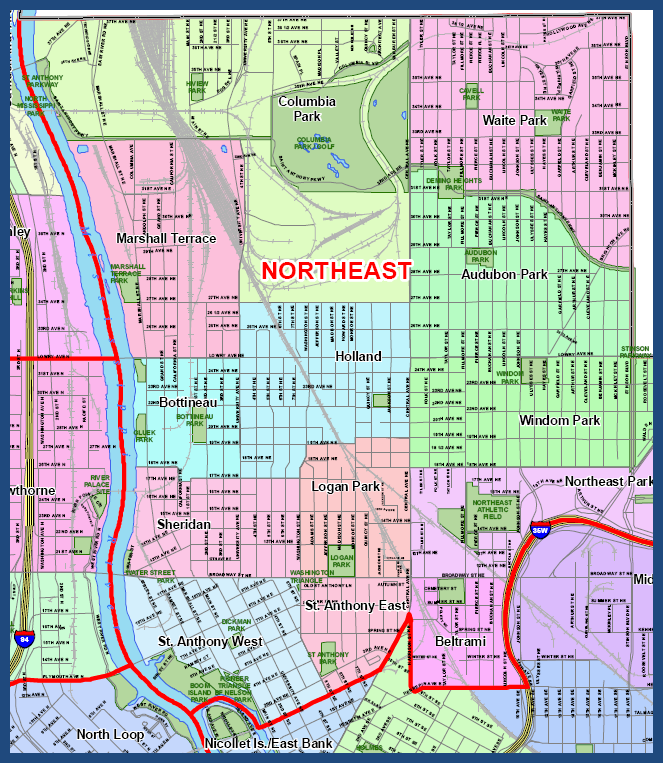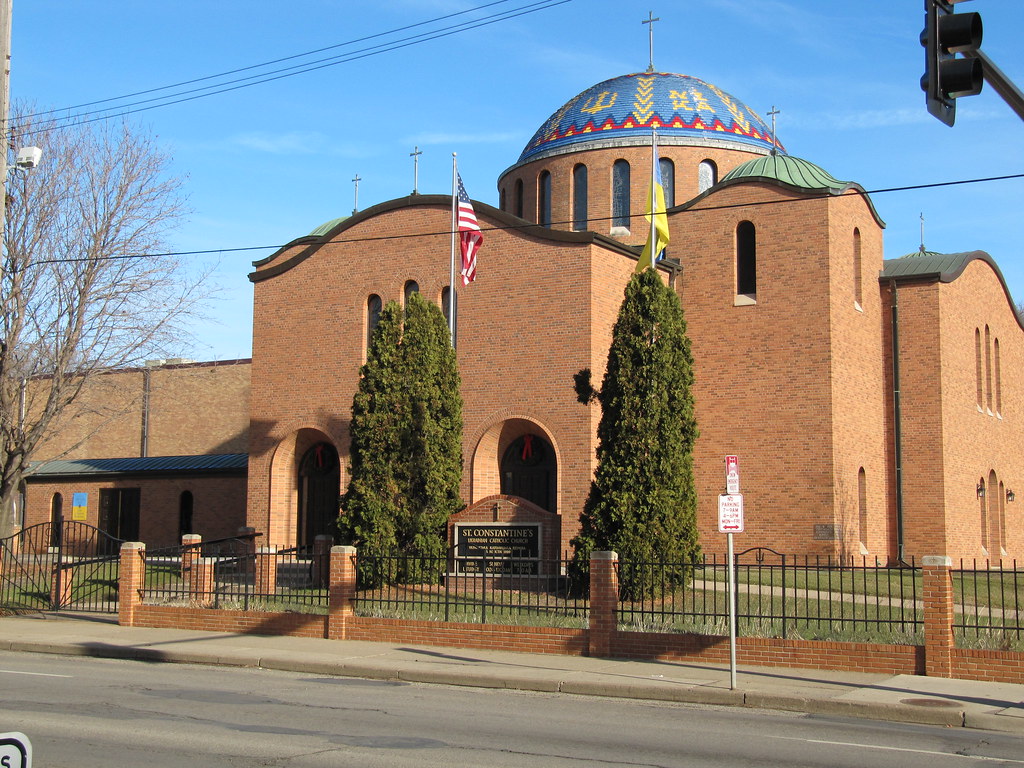This post is about Ukrainian immigrants to Minneapolis, Minnesota and their efforts to establish a place of worship in one specific area of the city, Northeast Minneapolis. One of the first things that immigrant groups did after they became established in the United States was to start a place of worship. The first Ukrainians came to Minneapolis in the 1878 from the Austrian-Hungarian Empire. At that time they were called Rusyns or Ruthenians, a name that came associated with the place of their origin, the Kievian Rus. Most of the immigrants in Minneapolis were from Galicia, the eastern-most area of the Austrian Empire and were Greek Catholics, who followed the Eastern Rite, which is similar to the Orthodox Church. Other Ukrainians/Rusyns came from Transcarpathian Ukraine, which bordered the Carpathian Mountains, Slovakia, Poland and Hungary. In 1596, Orthodox Ukrainians in the Polish-Lithuanian Commonwealth, merged with the Roman Catholic Church, but kept the religious practices and beliefs of the Orthodox Church, including marriage of priests. This new church was called the Uniate or Greek Catholic Church. The fact that the church allowed married priests, as in the Orthodox Church did would cause conflict in the Ukrainian community in the United States.
The first Ukrainian Greek Catholic priest in the United States, John Voliansky, came from Lviv to start a church in Shenandoah, Pennsylvania in 1884. Shortly after his arrival, he traveled to Philadelphia to present his credentials to Roman Catholic Archbishop Patrick Ryan. The Archbishop refused to see him because he was married. He was told by the Archbishop's chancellor to return immediately to Lviv. Voliansky ignored this, realizing that only his superiors in Lviv could end his mission.
 |
| Northeast Minneapolis is the area within the red line |
Ruthenians establish a Church in Northeast Minneapolis.
Northeast is the oldest part of Minneapolis. The city is divided in half by the Mississippi River. It is divided again into quarters. On the east side of the river is North East and South East. North and South are on the west side of the River. Ruthenian/Rusyn immigrants settled in Northeast Minneapolis, an area with many industries and businesses where they found work.At first they attended a Polish Roman Catholic Church in the neighborhood. By 1889, there were enough Ukrainian/Ruthenian/Rusyn Greek Catholics in Minneapolis to start their own church. Rev. Voliansky came to Minneapolis from Pennsylvania to help the immigrants to organize their church. Reverend Alexis Toth, a widowed priest from Transcarpathia, came to Minnesota to be the pastor of the new church. He also had problems with the Roman Catholic hierarchy. When he arrived in Minnesota, he introduced himself to the Bishop of St Paul, John Ireland. When Bishop Ireland found out that Rev. Toth had been married, he told him that there was no place for married or widowed priests in the Roman Catholic Church and to leave Minnesota. Toth decided to stay in Minneapolis, and the first Greek Catholic Church was established in Minneapolis.
The First Greek Catholic Church in Minneapolis: St Mary's Greek Catholic Church founded in 1889.
 |
| St Mary's Orthodox Cathedral built in 1906 |
 |
| Father Alexis Toth |
St Mary's Greek Catholic Church at 1701 5th St N.E. was founded in 1889, Father Toth was the pastor there from 1889 to 1891. Because he had been married, the Roman Catholic Church would not support Father Toth and his new church, so he started a grocery store to support himself and the church. The church grew, but eventually Toth realized since there was no place for him in the Roman Catholic Church, he would convert to the Orthodox faith. At that time, there was no Ukrainian Orthodox Church in the United States or anywhere else in the world, so he joined the Russian Orthodox Church. He started a return to Orthodoxy movement and over 7000 Greek Catholic Rusyns joined him. He received pastoral and financial help from the Russian Orthodox Church, based in Moscow and from the Tsar. St Mary's became a Russian Orthodox Church in 1883 with Father Toth as its pastor. In 1905, a Russian Orthodox seminary was opened at St Mary's, the first in the United States. The original church, built in 1887 burned down in 1905 and was replaced by a much larger building in 1906, funded by the Russian Orthodox Church. By 1916, there were almost 100,000 members of the Russian Orthodox Church in the United States, and 80% of them were Ukrainian.
Because of his leadership in establishing the Russian Orthodox Church in Minnesota and starting the first Russian Orthodox Seminary in the United States, Father Alexis Toth became a Russian Orthodox saint in 1994.
St John the Baptist Ruthenian Greek Catholic Church, founded in 1907.
 |
| St John the Baptist Byzantine Catholic Church. It is the second building, built in 1926. |
St Constantine Ukrainian Catholic Church, founded in 1912.
 |
| St Constantine Ukrainian Catholic Church, built in 1972. |
World War I was a difficult time for Ukrainians in the United States, since many of the battles were fought in Galicia, their homeland. Since many had family members still living there, they followed news of the war closely. Although World War I ended in 1918, fighting continued until 1920, when Galicia became part of Poland and Transcarpathian Ukraine became part of Hungary and Romania.
Ukrainian immigrants opened the Ukrainian National Home in Minneapolis, a social club and a place where they could keep Ukrainian traditions alive.
After the collapse of Russia, Ukrainian immigrants were inspired by the short lived independence of Ukraine. When Ukrainians broke away from the Russian Orthodox Church and started a new church, the Ukrainian Autocephalous Church in Ukraine in 1921, immigrants in Minneapolis followed these events closely. So when Archbishop John Theodorovych of the new Ukrainian Orthodox Church spoke at the Ukrainian National Home in 1925, his speech inspired several members of St Constantine's Church to meet and discuss the possibility of establishing a Ukrainian Orthodox Church in Minneapolis. One concern of many immigrants was that The Greek Catholic Church was becoming more and more like the Roman Catholic Church and that Ukrainian cultural and national traditions were neglected. This new church was going to be different, it would continue Ukrainian religious traditions, but it would also work to develop Ukrainian nationalism and and preserve its culture.
St Michael's Ukrainian Orthodox Church is founded in 1925.
-of-Philadelphia-(1887-1971).jpg) |
| Archbishop John Theodorovych |
St Michael's Ukrainian Orthodox Church was founded for several reasons. According to Alexander Granovsky, who wrote a history of the Church on its 50th anniversary in 1975:
The Church became the center of the Ukrainian Community in Minneapolis, provided not only religious guidance, but also cultural and educational leadership.First, there was dissatisfaction with the progressive Latinization of their own and of the Uniate Church. Second, it was a move to have the opportunity to maintain their own correct national identity and to carry on their Ukrainian patriotic life and to help their kinsmen in Ukraine...and to continue their fight for national freedom. Third, The undoubted stimulation of the power of the rebirth of the ancient Ukrainian National Orthodox Church in 192. It was not like erecting a church for an old parish--it was creating the first church for one of the first new parishes of the Ukrainian Autocephalous Orthodox Church in America!
| St Michal's Ukrainian Orthodox Church at 505 4th NE, one block from St Constantine's Church |
No comments:
Post a Comment